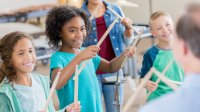Seizing Informal Moments to Deepen Student Learning in Music Classes
Music teachers can support the learning process creatively and organically while staying focused on curriculum goals and standards.
PHWAP! The band leader held up two fingers. PHWAP! PHWAP! Now five fingers. PHWAP! PHWAP! PHWAP! PHWAP! PHWAP! “Hit me 10 times…” PHWAP! PHWAP!…
I was in high school, and this would prove to be one of my most important music education lessons. The band leader/piano player on the stage at summer camp was directing the drummer and bassist for a wild ending to a song we had all been jumping and dancing to. Each “PHWAP” was an explosion of drums, bass, and piano.
“One time.” PHWAP! “Two times.” PHWAP! PHWAP! (Is it over?) “One time!” PHWAP! The audience was going crazy; everyone loved it. Over the next 25 years, when I wanted an ending that would get students’ attention and get them laughing, jumping, and loving it: One time—PHWAP! Two times—PHWAP! PHWAP! Fifteen times!...
Informality Can Support Curriculum Goals
This type of informal learning wasn’t an unusual part of my music education. I had many years of formal music instruction, but informal moments like this had an outsized effect on my development as a musician and teacher. In my teaching, I deliberately work to utilize this kind of informality in my classroom.
In life outside of school, although informal learning is powerful and enduring, it is also often nonlinear and disjointed. With creativity, an open mind, and a long-term view of success in learning, teachers can leverage the best parts of informal teaching while still attending to structured curriculum and standards.
Invite Students to the Jam Session
Informal learning can start with creating experiences that students can join in without preparation. Paraphrasing the work of music educator John Feierabend, a strategy for music is simply to start singing and let the joy and interest of the song pull the students in. Particularly with young students, if you start singing an engaging song that they can make sense of, they will soon start to sing along without prompting. This also works for playing instruments, dancing, and other music-making activities.
This is what it looks like in my classroom. A music teacher friend of mine posted a great performance of her students on Facebook and wrote an article about these types of performances. I use the video as a virtual jam session that my students can participate in. “Do you think you can figure out how to play that drum part?” “Check out the bass player—can you clap that rhythm?” Starting with clapping and vocalizing parts, my students were eager to create the music that they had heard.
Rather than beginning with “Here is the sheet music for the next piece we’re going to learn,” the lesson started with this virtual jam session. All of the curriculum standards were checked off but packaged in a way that made it seem like we were just having fun with the kids from my friend’s school.
Through the use of video sharing/archival tools like Seesaw and even Twitter, I have begun to amass a large library of former student performances that give us a chance to enter into regular jam sessions with them. Just this week, third-grade students learned a new dance with a percussion part by watching student performances from two and three years ago. Many students had brothers, sisters, and neighbors in the performance that they enjoyed watching and learning from.
Start With the Students
Academic subjects don’t exist in a vacuum, and students are interacting with subject area content all the time. So for informal learning, the question isn’t how do we bring these concepts to the students, but rather how do we respond as students bring these concepts to us?
I often have students begging to play songs from home for their classmates. This presents several natural opportunities for learning. Before a student plays, we talk about how we’re going to respond as an audience. Most of the time, it’s appropriate to sit quietly and hold the applause until the end of the piece. The in-class performance gives us a chance to practice this in a low-pressure environment where the students can retry listening and playing as many times as necessary.
After this objective has been met, I try to tie what we’ve been learning into the students’ performance and the class response. When students were learning about tempo and a student had a piece to play, I challenged the student to play the piece at various tempos and had the students respond with improvised movement. I could’ve played a piece myself with modulating tempos, but having the student play created automatic differentiation and made the learning natural to what was going on in their lives.
When unexpected things happen in the classroom, they can often be integrated into the learning rather than having to ignore what students are feeling or placing the curricular objectives on hold. One day there was a small four-legged friend that was interested in playing xylophones with my students. After a few minutes of screaming and chasing this friend out of our space, the only way forward was to integrate this experience into our learning.
The Indonesian lyrics for the song we were learning transformed into riffs on the mouse in our classroom.
Just-in-Time Learning
As students learn in these informal ways, specific learning objectives organically develop. In the jam session example, students learned mallet technique, rhythm, tempo, balance, etc. These weren’t abstract terms for the students, but specific obstacles they needed to overcome to reach the goal. This just-in-time learning makes learning urgent and engaging. There’s no question of “When are we going to use this?” It’s being used right now.
